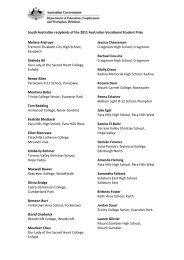Belonging, Being and Becoming - Early Years Learning Framework
Belonging, Being and Becoming - Early Years Learning Framework
Belonging, Being and Becoming - Early Years Learning Framework
Create successful ePaper yourself
Turn your PDF publications into a flip-book with our unique Google optimized e-Paper software.
PRACTICE<br />
natural environments include plants, trees, edible<br />
gardens, s<strong>and</strong>, rocks, mud, water <strong>and</strong> other elements<br />
from nature. These spaces invite open-ended<br />
interactions, spontaneity, risk-taking, exploration,<br />
discovery <strong>and</strong> connection with nature. They foster<br />
an appreciation of the natural environment, develop<br />
environmental awareness <strong>and</strong> provide a platform<br />
for ongoing environmental education.<br />
Indoor <strong>and</strong> outdoor environments support<br />
all aspects of children’s learning <strong>and</strong> invite<br />
conversations between children, early childhood<br />
educators, families <strong>and</strong> the broader community.<br />
They promote opportunities for sustained shared<br />
thinking <strong>and</strong> collaborative learning.<br />
Materials enhance learning when they refl ect<br />
what is natural <strong>and</strong> familiar <strong>and</strong> also introduce<br />
novelty to provoke interest <strong>and</strong> more complex <strong>and</strong><br />
increasingly abstract thinking. For example, digital<br />
technologies can enable children to access global<br />
connections <strong>and</strong> resources, <strong>and</strong> encourage new<br />
ways of thinking. Environments <strong>and</strong> resources can<br />
also highlight our responsibilities for a sustainable<br />
future <strong>and</strong> promote children’s underst<strong>and</strong>ing about<br />
their responsibility to care for the environment.<br />
They can foster hope, wonder <strong>and</strong> knowledge about<br />
the natural world.<br />
Educators can encourage children <strong>and</strong> families to<br />
contribute ideas, interests <strong>and</strong> questions to the<br />
learning environment. They can support engagement<br />
by allowing time for meaningful interactions, by<br />
providing a range of opportunities for individual <strong>and</strong><br />
shared experiences, <strong>and</strong> by fi nding opportunities<br />
for children to go into <strong>and</strong> contribute to their local<br />
community.<br />
Cultural competence<br />
Educators who are culturally competent respect<br />
multiple cultural ways of knowing, seeing <strong>and</strong> living,<br />
celebrate the benefi ts of diversity <strong>and</strong> have an<br />
ability to underst<strong>and</strong> <strong>and</strong> honour differences. This<br />
is evident in everyday practice when educators<br />
demonstrate an ongoing commitment to developing<br />
their own cultural competence in a two way<br />
process with families <strong>and</strong> communities.<br />
Educators view culture <strong>and</strong> the context of family<br />
as central to children’s sense of being <strong>and</strong> belonging,<br />
<strong>and</strong> to success in lifelong learning. Educators also<br />
seek to promote children’s cultural competence.<br />
16 BELONGING, BEING & BECOMING The <strong>Early</strong> <strong>Years</strong> <strong>Learning</strong> <strong>Framework</strong> for Australia<br />
Cultural competence is much more than awareness<br />
of cultural differences. It is the ability to underst<strong>and</strong>,<br />
communicate with, <strong>and</strong> effectively interact with<br />
people across cultures. Cultural competence<br />
encompasses:<br />
• being aware of one’s own world view<br />
• developing positive attitudes towards cultural<br />
differences<br />
• gaining knowledge of different cultural practices<br />
<strong>and</strong> world views<br />
• developing skills for communication <strong>and</strong><br />
interaction across cultures.<br />
Continuity of learning <strong>and</strong> transitions<br />
Children bring family <strong>and</strong> community ways of being,<br />
belonging <strong>and</strong> becoming to their early childhood<br />
settings. By building on these experiences educators<br />
help all children to feel secure, confi dent <strong>and</strong><br />
included <strong>and</strong> to experience continuity in how to be<br />
<strong>and</strong> how to learn.<br />
Transitions, including from home to early childhood<br />
settings, between settings, <strong>and</strong> from early childhood<br />
settings to school, offer opportunities <strong>and</strong><br />
challenges. Different places <strong>and</strong> spaces have their<br />
own purposes, expectations <strong>and</strong> ways of doing<br />
things. Building on children’s prior <strong>and</strong> current<br />
experiences helps them to feel secure, confi dent<br />
<strong>and</strong> connected to familiar people, places, events<br />
<strong>and</strong> underst<strong>and</strong>ings. Children, families <strong>and</strong> early<br />
childhood educators all contribute to successful<br />
transitions between settings.<br />
In partnership with families, early childhood<br />
educators ensure that children have an active role<br />
in preparing for transitions. They assist children to<br />
underst<strong>and</strong> the traditions, routines <strong>and</strong> practices of<br />
the settings to which they are moving <strong>and</strong> to feel<br />
comfortable with the process of change.<br />
<strong>Early</strong> childhood educators also help children to<br />
negotiate changes in their status or identities,<br />
especially when they begin full-time school. As<br />
children make transitions to new settings (including<br />
school) educators from early childhood settings <strong>and</strong><br />
schools commit to sharing information about each<br />
child’s knowledge <strong>and</strong> skills so learning can build<br />
on foundations of earlier learning. Educators work<br />
collaboratively with each child’s new educator <strong>and</strong><br />
other professionals to ensure a successful transition.





